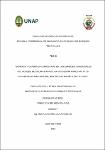Biomasa y carbono almacenado en las especies comerciales del bosque de colina baja de la concesión forestal n° 16-LOR-MAY/CON-MAD-2017-024, distrito de Mazán, Loreto. 2021
Abstract
The biomass and the carbon stock in the commercial species of a low-hill forest of the Mazán district, Loreto, Peru, were quantified. The data from the forest census of commercial species of the operative plan (PO) 1 of the felling plot (PC) 6 of the forest concession contract for timber purposes N° 16-LOR-MAY/CON-MAD-2017-024 was evaluated. The results indicate a total biomass of 2 092 812,87 kg and 2379,28 kg/ha, where V. calophylla reports the highest amount of total biomass of 964 884,26 kg and 1096,96 kg/ha and C. racemosa reports the lowest amount of total biomass of 631 802,44 kg and 252,72 kg/ha. The carbon stock is 31 959,42 tC and 12,78 tC/ha. V. calophylla (3643,23 tC and 1,46 tC/ha) and A. brasiliensis (3158,88 tC and 1,26 tC/ha) report the highest stocks; while A. giganteum with 456,78 tC and 0,18 tC/ha and C. racemosa with 315,90 tC and 0,13 tC/ha show the lowest stocks. The diameter classes of 90 cm + (8501,12 tC and 3,40 tC/ha) and 60 cm to 69 cm (7606 tC and 3,04 tC/ha) contain the highest amount of carbon stock; while the diameter classes 50 cm to 59 cm (3967,46 tC and 1,59 tC/ha) and 80 cm to 89 cm (4868,51 tC and 1,95 tC/ha) contain the least amount of carbon stock. Se cuantificó la biomasa y el carbono almacenado en las especies comerciales de un bosque de colina baja del distrito de Mazán, Loreto, Perú. Se evaluó los datos del censo forestal de las especies comerciales del plan operativo (PO)1 de la parcela de corta (PC) 6 del contrato de concesión forestal con fines maderables N° 16-LOR-MAY/CON-MAD-2017-024. Los resultados indican una biomasa total de 2 092 812,87 kg y 2379,28 kg/ha, donde V. calophylla reporta la mayor cantidad de biomasa total de 964 884,26 kg y 1096,96 kg/ha y C. racemosa reporta la menor cantidad de biomasa total de 631 802,44 kg y 252,72 kg/ha. El carbono almacenado es de 31 959,42 tC y 12,78 tC/ha. V. calophylla (3643,23 tC y 1,46 tC/ha) y A. brasiliensis (3158,88 tC y 1,26 tC/ha) reportan los mayores stocks; mientras que A. giganteum con 456,78 tC y 0,18 tC/ha y C. racemosa con 315,90 tC y 0,13 tC/ha muestran los menores stocks. Las clases diamétricas de 90 cm a + (8501,12 tC y 3,40 tC/ha) y de 60 cm a 69 cm (7606,00 tC y 3,04 tC/ha) contienen la mayor cantidad de carbono almacenado; mientras que las clases diamétricas de 50 cm a 59 cm (3967,46 tC y 1,59 tC/ha) y de 80 cm a 89 cm (4868,51 tC y 1,95 tC/ha) contienen la menor cantidad de carbono almacenado.
Collections
- Tesis [408]


